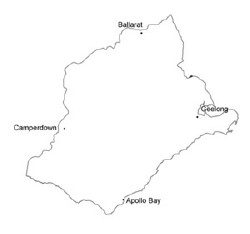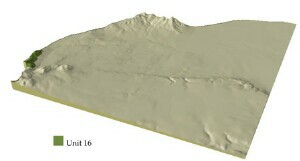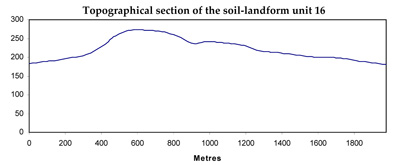Soil/Landform Unit 16
Landform Unit Description
Page top
 The rolling low hills in the Mount Rothwell and Anakie Junction area have very rocky slopes with tors as a common feature |
0.02% of CMA region This area of rolling hills occur within the Mount Rothwell and Anakie Junction areas on the eastern boundary of the Corangamite catchment. The hills are characterised by areas of prominent rock outcrop and gentler rock-free slopes and saddles. Within the Midlands of the Western Uplands these granitic hills are characterised by acidic mottled yellow duplex soils with coarse sands. The crests and steeper slopes have coarse sands. Deep uniform sand soils occur in the vicinity of rock outcrops and tors. Remnant vegetation includes Hills Herb-rich Woodland and Granitic Hills Woodland. Land use is restricted to grazing on native or introduced pastures due to steepness and soil qualities such as low available water holding capacity and ready leaching of nutrients. The sand surfaces are prone to sheet erosion by water and wind. Gully erosion occurs to a minor extent and can be difficult to control due to the steepness and inaccessibility of the drainage depressions. |  |
 The granitic rolling low hills are surrounded by colluvial slopes of Unit 204 |  |
|
Component | 1 | 2 | 3 |
Proportion of soil-landform unit | 15% | 35% | 50% |
| CLIMATE Rainfall (mm) | Annual: 680 | ||
| Temperature (oC) | Minimum 8, Maximum 18 | ||
| Precipitation less than potential evapotranspiration | October-March | ||
| GEOLOGY Age and lithology | Devonian granite and Neogene fluvio-marine sediments | ||
| Geomorphology | |||
| LANDUSE | Uncleared: Nature conservation; passive recreation Cleared: Sheep and beef cattle grazing; cropping (cereal) limited | ||
| TOPOGRAPHY Landscape | Rolling low hills | ||
| Elevation range (m) | 179-283 | ||
| Local relief (m) | 100 | ||
| Drainage pattern | Dendritic | ||
| Drainage density (km/km2) | 0.25 | ||
| Landform | Rolling hills and tors | ||
| Landform element | Bare rocky crests (tors), very rocky upper slopes | Rocky mid slopes | Lower slopes |
| Slope and range (%) | 5 (1-10) | 6 (3-15) | 4 (2-8) |
| Slope shape | Convex | Straight | Concave |
| NATIVE VEGETATION Ecological Vegetation Class | Hills Herb-rich Woodland (7.3%), Granitic Hills Woodland (4.9%) | ||
| SOIL Parent material | In situ granite | In situ granite | In situ granite and colluvium |
| Description (Corangamite Soil Group) | Acidic mottled yellow texture contrast soils (3) and deep uniform sand soils (4) | Acidic mottled yellow texture contrast soils (3) | Acidic mottled yellow texture contrast soils (3) |
| Soil type sites | |||
| Surface texture | Coarse sandy clay loam, loamy sand | Coarse sandy clay loam | Coarse sandy clay loam |
| Permeability | Very high | High to moderate | Moderate |
| Depth (m) | <1.5 | <1.5 | >2 |
| LAND CHARACTERISTICS, POTENTIAL AND LIMITATIONS | Rocky slopes with texture contrast or sandy soils. Low water holding capacity and nutrient hilding capacity in surface and (bleached) subsurface soil, high in subsoil. Generally hardsetting with rapid site drainage. Susceptibility to nutrient decline as well as sheet and rill erosion. | Some stone, coarse sand component. Texture contrast with low water holding capacity and nutrient holding capacity in surface and (bleached) subsurface soil, high in subsoil. Generally hardsetting with rapid site drainage. Susceptibility to nutrient decline as well as sheet and rill erosion. | Corse sand component to topsoil. Texture contrast with low water holding capacity and nutrient holding capacity in surface and (bleached) subsurface soil, high in subsoil. Generally hardsetting with rapid site drainage. Susceptibility to nutrient decline as well as sheet and rill erosion. |



